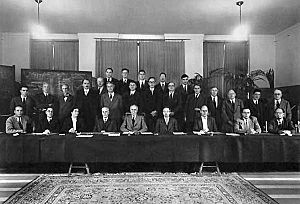Alan Cottrell facts for kids
Quick facts for kids
Alan Cottrell
|
|
|---|---|
| Born | 17 July 1919 Birmingham, Warwickshire (now West Midlands)
|
| Died | 15 February 2012 (aged 92) Cambridge, Cambridgeshire
|
| Nationality | English |
| Citizenship | British |
| Alma mater | University of Birmingham |
| Known for | Cottrell atmosphere Lomer–Cottrell junction Crack tip opening displacement |
| Awards | Fellow of the Royal Society Hughes Medal (1961) Harvey Prize (1974) Rumford Medal (1974) Copley Medal (1996) |
| Scientific career | |
| Fields | Metallurgist, Physicist |
Sir Alan Howard Cottrell (born July 17, 1919 – died February 15, 2012) was a brilliant English scientist. He was a metallurgist, meaning he studied metals and how they behave. He was also a physicist, someone who studies how the world works at a basic level.
Sir Alan was very important in science. He even served as the main science advisor to the UK government for a time. Later, he was in charge of Cambridge University as its vice-chancellor from 1977 to 1979. He was known for his work on things like the Cottrell atmosphere, which helps us understand how metals bend and break.
Contents
Early Life and Education
Alan Cottrell grew up in England. He went to Moseley Grammar School. After that, he studied at the University of Birmingham.
He earned his first science degree in 1939. Then, in 1942, he got his PhD. His research for his PhD was all about welding, which is how you join pieces of metal together.
A Career in Science
After finishing his studies, Alan Cottrell started working at the University of Birmingham. He became a professor in 1949. He changed how science was taught there. He made sure students learned about modern ideas in solid state physics. This field studies how solid materials, like metals, are put together.
In 1955, he moved to the Atomic Energy Research Establishment at Harwell. This was a special place where scientists studied atomic energy. He became a top leader in their metallurgy department.
Working at Cambridge University
From 1958 to 1965, Cottrell was a professor at Cambridge University. He held a special position called the Goldsmiths' Professor of Metallurgy. He was also a fellow at Christ's College.
Government Science Advisor
After his time at Cambridge, Sir Alan worked for the government. He helped them with many science-related issues. From 1971 to 1974, he was the Chief Scientific Adviser to the UK Government. This meant he was the top science expert advising the whole country!
Leading Jesus College
Later, he became the Master of Jesus College, Cambridge. He held this important role from 1973 to 1986. He also served as the Vice-Chancellor of Cambridge University from 1977 to 1979. This is like being the principal of the entire university.
Death
Sir Alan Cottrell passed away on February 15, 2012. He had been ill for a short time.
Awards and Honors
Sir Alan Cottrell received many important awards for his scientific work:
- In 1955, he was chosen as a Fellow of the Royal Society. This is a very high honor for scientists in the UK.
- He won the Hughes Medal in 1961.
- In 1962, he received the Francis J. Clamer Medal.
- He was given the Royal Society Bakerian Medal in 1963.
- In 1965, he was the very first person to receive the A. A. Griffith Medal and Prize.
- He won the James Alfred Ewing Medal in 1967.
- In 1969, he received the Fernand Holweck Medal and Prize.
- He was made a knight in 1971. This is why he is called "Sir Alan."
- He received an honorary degree from the University of Bath in 1973.
- In 1974, he was awarded the James Douglas Gold Medal.
- He received another honorary doctorate from the University of Essex in 1982.
- In 1996, he was given the Copley Medal. This is the highest award from the Royal Society.
He was also a member of the Royal Swedish Academy of Sciences.
Selected Books
Sir Alan Cottrell wrote several books about science:
- Theoretical Structural Metallurgy (1948)
- Dislocations and Plastic Flows in Crystals (1953)
- Superconductivity (1964)
- An Introduction to Metallurgy (1967)
- Portrait of Nature : the world as seen by modern science (1975)
- How Safe is Nuclear Energy? (1982)
- Concepts in the Electron Theory of Alloys (1998)
See also
- Creep (deformation)


